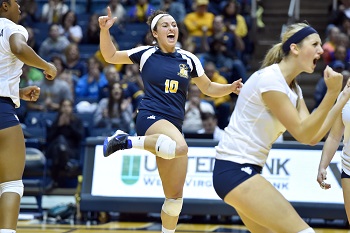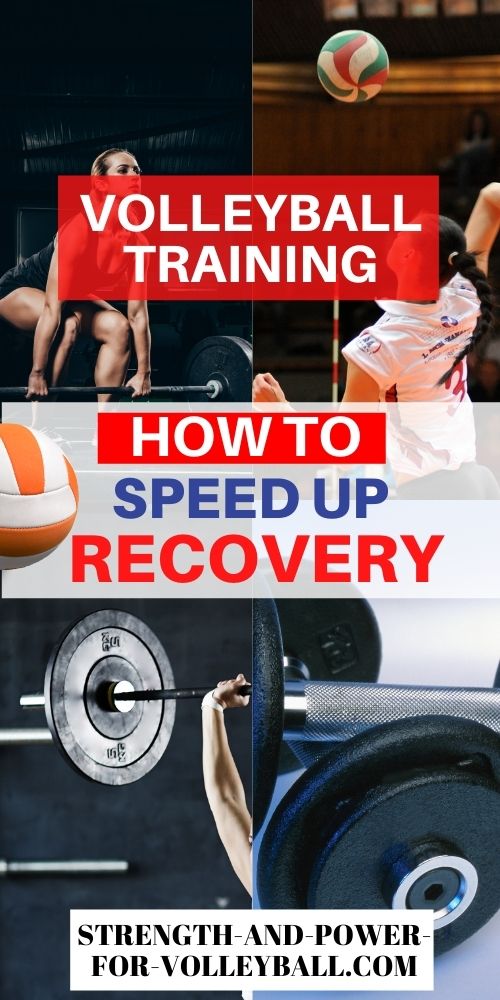- Home
- Smarter Training
- volleyball recovery
Volleyball Recovery Tips
Exercises to Speed Up Down Time
Why is volleyball recovery time important? A faster recovery allows you to train more often and train harder so you get more out of your training.
During volleyball recovery, this is the time you make gains in strength and power. During the workout you break down your body...it's during recovery that your body heals and grows stronger.
All areas of your life affect the recovery process
Do you know that you actually experience the benefit of your hard work on the days that you rest and repair your body?
You need to follow a plan of recovery, both physically and mentally, in all areas of your life.
Most athletes don't understand how important the recovery process is.
How you spend your time away from training is very important. For
example, if you workout an hour each day, how you spend the other 23
hours of the day influences your volleyball recovery. The time away from training
is when you make significant gains in performance.
If you're working out hard all the time, you never truly recover
If you workout hard all the time and never spend time actively recovering, then you aren't working out smart.
You don't want to do nothing on your off days. Light exercise on your off days
will help you recover faster.
There's a big difference between "doing nothing at all" and "active rest".
Active rest helps your body recover faster.
You might be working out hard, but if you aren't recovering properly then you
could be so mentally and physically fatigued that your workouts aren't nearly as
productive as they could be.
Staying Active and Having Fun
Tips to Recover Faster
The following are tips to help recover faster from training...
- Get enough sleep. Sleep is the most underrated aspect of volleyball recovery. For all the talk about improving diet and exercise, we tend to ignore this obvious lifestyle component. During sleep, your body produces hormones which are largely responsible for tissue growth and repair.
- Self massage. Foam rollers are the poor mans massage therapist.
The foam roller can provide unlimited self-massage for under twenty
dollars. What
you do with a foam roller is basically use your bodyweight to apply
pressure to sore spots. This is kind of like a self-acupressure
technique.
The Roller I Recommend - The purpose of the self massage is to manipulate muscle soft tissue, causing athletes to either stay healthier or, to get healthy faster. Athletes are instructed to use the roller to search for tender areas or trigger points and to roll these areas to decrease density and over-activity.
- Stretching. Both static stretching and dynamic stretching is important for recovery.
- Eating right. After depleting your energy stores with exercise,
you need to refuel if you expect your body to recover. You need to eat
in order to repair tissues, get stronger and be ready for the next
challenge.
Consuming foods that contain carbohydrates right after training while
your body is still warm is good to help replenish muscle glycogen.
Replenishing muscle glycogen is especially important for strength and power athletes because this is the main energy source used during your performance.
- Cool down. Continuing to move around at a very low intensity for 5 to 10 minutes after a workout helps remove lactic acid from your muscles and may reduce muscles stiffness.
Ice Bath
- Contrast water therapy. Many athletes swear by ice baths, ice massage or alternating hot and cold showers to recover faster, reduce muscle soreness and prevent injury. This method of speeding up recovery works by repeatedly constricting and dilating blood vessels, helping remove (or flush out) waste products in the tissues.
- Light exercise. Getting in some light exercise such as walking or playing another sport on your off days can help promote nutrient and waste product transport throughout the body. Performing light exercise will help muscles repair and refuel faster for your next hard training session.
- Replace fluids and electrolytes. Ideally, you should be replacing
water and electrolytes during exercise. Key electrolytes are sodium,
potassium, and calcium. Sodium needs to be replaced because it's lost
during exercise through sweating.
Potassium is important because it helps your muscles and nerves function
properly.
Potassium is found abundantly in many foods, and is especially easy to obtain in fruits and vegetables. Athletes with low potassium stores may tire more easily during exercise, as potassium deficiency causes a decrease in muscle glycogen storage. Many athletes consume bananas because of the high amounts of potassium.
Many sport drinks such as Gatorade and Powerade have electrolytes. Electrolytes are important because they help you maintain the proper electrolyte and acid-base balance in your body which is critical to performance in strength and power sports.
If you enjoyed these tips and would like to keep it close to you at any time, just save this pin to your Pinterest Volleyball Training Board.
Fluids to Help Hydrate
- Minimize oxidative damage caused by exercise.
Exercise greatly increases the generation of free radicals, which can
result in enhanced damage to muscles and other tissues. This is
particularly a concern for
untrained athletes that perform intense exercise that overwhelms
defenses resulting in increased free radical damage.
To avoid free radical damage, be sure you're following a balanced fitness program that emphasizes regular exercise and eat 5 servings of fruit or vegetables every day. This will ensure that you are developing your inherent antioxidant systems and that your diet is providing the necessary components.
Eating Right helps Volleyball Recovery
- Avoid overtraining. You need to follow a well designed volleyball strength and conditioning program for faster volleyball recovery and for preventing overtraining. Training too often will limit your volleyball strength gains and undermine your recovery efforts.

